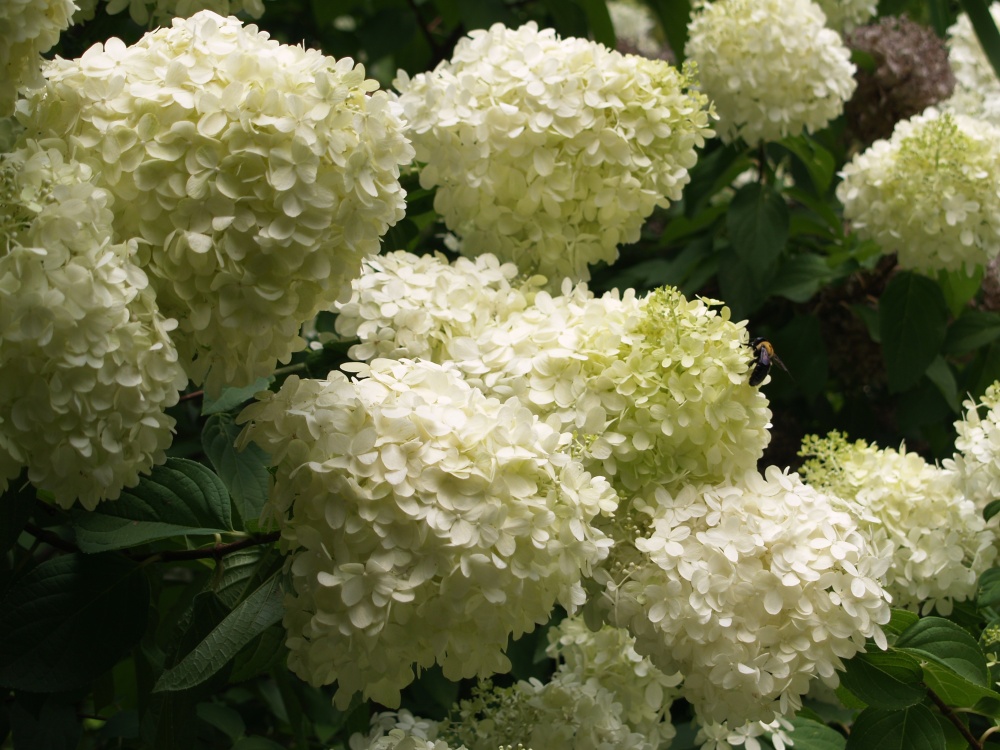Finally, I’m back home from two weeks on the road visiting nurseries in the southeast. That’s three thousand miles of interstates, dusty back roads, and bumping around through tree nurseries. More hollies and junipers than I can count, and roses, hydrangeas, and azaleas that will appear in our garden centers in the spring.
There are some exciting new plants on the horizon, but today I’m pleased to be home, and delighted that the garden is in fine shape, even with a week of upper nineties and one hundred degree temperatures today.
The earliest of the toad lilies (Tricyrtis, above) has begun to flower, the beginning of two months of bloom for the five or six varieties in the garden. In past years this variegated-leaf toad lily grew more open and leggy than others, so I pruned it in mid-summer so that flower buds formed later, and it did not bloom until early September. The plants were lush and full, but more compact growing this summer, and without pruning have been the first to bloom, not the last.
I see toad lilies in gardens only occasionally, and wonder why this easy-to-grow, carefree perennial is not planted more often. It is not a show stopper from a distance, and perhaps for this reason it is not more common, but there are no flowers more splendid in the late summer garden upon close up inspection.
The pineapple lily (Eucomis ‘Sparkling Burgundy’, above) is in its last stages of splendor, and though the pineapple-like foliage and bloom are marvelous from a moderate distance, the waxy flowers are worthy of a look on hands and knees. This pineapple lily tripled in size this year, with three flowering stalks today, and I’ve grown more fond of this perennial and have planted a few other varieties. It requires little space, and no care, the foliage is pleasant, and the flowers beautiful. In this garden there is precious little space available, but I will find room for additional pineapple lilies.
Most of the crapemyrtles in the garden were blooming when I left a few weeks earlier, but the latest to bloom have begun just a day or two ago. The red flowered, fast growing Arapaho (above) has been planted for only a few years, and is now more than eight feet tall, though its habit is more upright and less spreading than others in the garden.
The dwarf, spreading, red Cherry Dazzle crapemyrtle (above) is the latest to bloom each year in my garden, but with the extended heat that we’ve experienced this summer I believe that it is flowering a few weeks earlier than in most years. Cherry Dazzle is part of a group of dwarfs marketed as Razzle Dazzle, and while it grows and blooms abundantly I’ve found the others to be quite disappointing, and I’ve removed them from the garden rather than deal with plants that were reluctant to grow or bloom. There have been a few recent additions to the series, and a white that appears in the nursery to be a significant improvement. I’ll plant a few, and give them a try, but it’s often two or three years before I’m convinced that a plant is worthy.
There is no doubt that panicle hydrangeas (above) are exceptional garden plants. Mophead and lacecap hydrangeas (a variegated-leaf lacecap, below) are delightful and more common because they are blooming mid-spring when customers are flocking to the garden centers, but Limelight, Tardiva, and other panicle hydrangeas begin blooming in the heat of July and are less likely to catch of the eye of impulse shoppers. These large shrubs are completely carefree, and will be covered in white blooms into September.

Summersweet (Clethra alnifolia ‘Ruby Spice’, above) is a native shrub that will tolerate shade and moist soils, but in my garden it must survive in dry soil and deeper shade than it would prefer. The foliage of summersweet is rather ordinary (though the common ‘Hummingbird’ has more glossy foliage), and its suckering, slowly spreading habit banishes it to the side and rear of the garden, but it is valuable in difficult locations and the fragrant blooms are quite nice.
On a walk through the garden in the heat of the afternoon there are butterflies and bumblebees buzzing from bloom to bloom. The butterflies are quite shy, and must be approached slowly to appreciate close up as they dart from salvia (above) to the blooms of the Franklin Tree (below), and back again. Franklinia will bloom for nearly two months, and butterflies and bees will visit it often as new flowers open.
The small blue flowers of blue mist shrub (Caryopteris, below) have slowly begun to open, and bumblebees will visit frequently over the month that they are blooming. Bumblebees barely take notice, considering me more a nuisance than a threat as I jut my nose and camera in their direction. I can only imagine the delight they find in these lovely blooms.
I enjoy looking at the flower pics. from the gardens. Thanks for showing these unusual plants, some of them new to me.